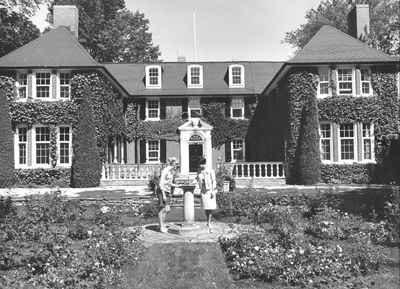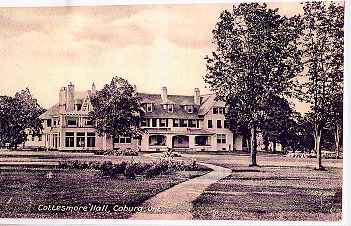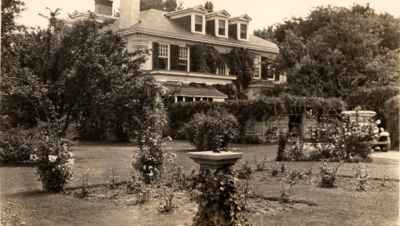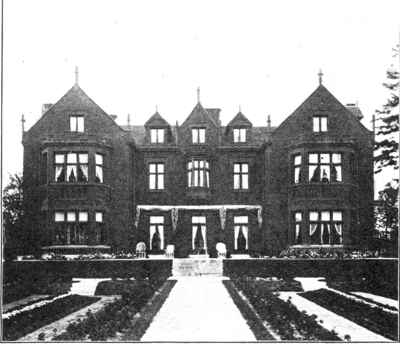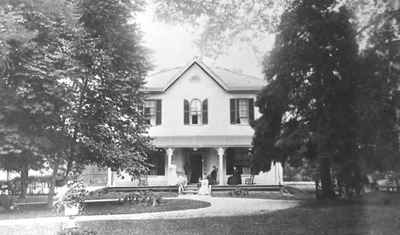The main features of this interesting house are the ornate porch and handsome window over it. The house itself was built in 1862 by George Goodeve. Shown here is an interesting Gentleman’s Cottage, which was built in the 1850’s. Erected by the Dickson family, this house is of Brunswick construction, which is to say, the walls are constructed of wood, with the boards placed one on top of the other. Also, the exterior is stuccoed and then incised to look like stone.
This is the only building in Cobourg that was constructed of cut sonte. It was built in 1847-48 by Alexander Sutherland. This four-square brick home was built by Andrew Hewson, a Cobourg merchant and pre-Confederation town councillor, in 1856. It is once again owned and occupied by his descendants today. This farmhouse on the east end of King Street was locally known as the 'Checkerboard House' and was built in 1878 by Leopold Kobald. Leopold was a butcher who came first to Montreal in 1844 and then to Cobourg in 1847. The Checkerboard House was his second home with over 200 acres included. He built up quite a business and had a stall at the Cobourg Market for 24 years. In 1881 he followed one of his sons to Winnipeg where they built up one of the largest butcher supply businesses in Canada. Considered one of the finest examples of Georgian architecture, the Barnum House was built in 1817 on the outskirts of Grafton by Col. Eliakim Barnum who came to Haldimand Township from Vermont in 1808. Barnum first used a large log house, but during the war of 1812 it was destroyed by a fire accidently set by soldiers. In 1817 he built this frame home entirely of white pine. Today it is a museum, furnished as a home of 150 years ago. Considered one of the finest examples of Georgian architecture, the Barnum House was built in 1817 on the outskirts of Grafton by Col. Eliakim Barnum who came to Haldimand Township from Vermont in 1808. Batterwood, home of the Massey family, Canton, Ontario Corilli Collard Field was born at Tavistock, Devon, England to John and Martha Field, who settled in Cobourg in 1834. He was a merchant in his father's store of Field & Brothers, importers of dry goods, groceries, etc. He was a councillor for twelve years, mayor for oneyear and M.P.P. in 1886, 1890 & 1894. James Crossen settled in Cobourg in 1852. He was first engaged in the foundry business and in 1870 began to manufacture railway cars. His business soon grew to be the finest in Canada and Cobourg's largest industry employing over 600 persons. In 1871, Crossen built an impresssive brick house, he named "Cedar Hedge". This fine brick residence was built this in 1851 by R. D. Chatterton, who came to Cobourg about 1830, and was the first editor of the Cobourg Star, which began publishing in 1831. Its proportions, massing, and detail give it a decidedly English flavor. Cottesmore Hall was the largest summer home in Cobourg and was built in 1910. It was built and owned by Wallace H. Rowe, president of the Pittsburgh Steel Company. The contractor responsible for building Cottesmore Hall was Constable Brothers of Pittsburgh and Erie PA. The Rowes owned the house till it was expropriated by the government for use as a a training school. It was demolished around 1974. Sepia colored photograph of D. Hooey residence once located on King Street where the Park Playhouse (formerly Park Theatre) is now. In 1857 Thomas Dumble built this Gothic Villa on the corner of George and Havelock Street. He was originally from Cornwall but he and his wife had lived in Dromore, County Down, Ireland which is why they chose this name. In the 1840’s, Thomas Dumble and his son, John Henry, surveyors, came to Canada to be part of a joint commission to settle the Maine – New Brunswick boundary dispute. Afterwards, the family settled in Cobourg and in 1857 Thomas Dumble built this imposing house called Dromore. Dungannon Farm was built in 1905 by the Olivers from Pittsburgh. The Oliver fortune was founded in steel, but the family later became the owners and editors of several leading Pittsburgh newpapers. General Charles Lane Fitzhugh was the youngest civil war general in the Union Army. The Fitzhughs were an old Virginia family of great wealth who spent much time in Cobourg. Charles built a pair of houses in 1902. Ravensworth, Fitzhugh built for himself and wife Emma Shoenberger, while East House he built for his son Carroll upon his marriage. The Fitzhugh family owned the East House until it was destroyed by a fire on Christmas Day in 1976. Erected in 1832 as a store, the building has since housed the Willis shoe store, Routh's restaurant, the Hydro office and Fisher's Dairy Bar. In 1908 the west half of the building was the Bijou Dream Theatre. Edwin C. Guillet home, James Street Details Originally built in 1870 by James Crossen for his son William, this large vernacular Victorian house was just south of Cedar Hedge. William remodelled it in 1895 which then made it a fine example of the Queen Anne Style. In 1910 the addition was added to the south and the inside of it resembles the interior of a luxurious railway carriage like those manufactured by the Crossens Car Works. On the far left is the home of Frank Field K.C.. On the far right is the home of Fred Field (212 King St. West), where Marie Dressler lived as a child. The Hayden family built this home in 1869. It originally faced George Street, but these lots were sold off for houses. The small cement block cottage on the east lot (with a George Street address) was used as an office for Dr. Edgar Hayden Dr. James Auston built this house in 1854 on church-owned land – hence the name Glebe Lawn. (Glebe being a plot of land belonging to an English parish church or an ecclesiastical office)It was sold in 1871 to Captain Henry Walker, who bought the house to use as a summer home. Dr. James Auston built this house in 1854 on church-owned land – hence the name Glebe Lawn. It was sold in 1871 to Captain Henry Walker, who bought the house to use as a summer home. Residence of Mrs. Eleanor Tracy of St. Louis. It was located at the extreme west end of Cobourg, just past Ravensdale. It was formerly the home of Postmaster-General the Hon. Sidney Smith and it was here in 1860 that later King Edward VII slept for a few hours when he toured Canada. This building was erected in 1838 by Reverend Alexander Bethune, later second bishop of Toronto, for use as a theological College for the training of Anglican priests and was known as the Diocesan Theological Institute. Later it became integrated into the University of Trinity College in Toronto. Built in 1884 by Agnes Heath of Toronto when her daughter Emily married D'Arcy Boulton who owned The Lawn. Heathcote and The Lawn shared a common boundary and both were built to be lived in year round rather than just as a summer home.It was bought by W.F.Ladd a wealthy Texas businessman in the cotton industry in the 1890s who enlarged it to the size seen in the old photographs. It then sold to Frank Hess from Philadelphia and then to Mrs. Dumble in 1920, who also now owned The Lawn. She had Heathcote demolished and made its grounds part of her lawn in 1930. Built by Mr. Hutchings in the late 1800s it was bought by Reuben Lawless in 1941. This house became better known as the Reuben F. Lawless home. This attractive Regency house was built in 1856 by Henry Meredith. The garage was originally a small livery stable. Home of Lazarus and Elizabeth Payne Details This home was built in 1873 by Major David Taylor. It was purchased by Lydia Cornell, daughter of Colonel Douglas Cornell in 1919. She made a number of changes to the home and lived there till 1958 when she died. Her niece, Katharine Cornell was married in this house in 1922. Marie Dressler was born in 1873. Her father Charles von Koerber was organist at St. Peter's Church and introduced Leila to the town's dramatic, musical and theatrical activites. During her professional career she starred in many movies throught the USA and Canada Believed to be the oldest house in Cobourg, it stands on the southeast corner of King and Church Street. This splendid residence was built in 1878 by Robert Mulholland, a wealthy merchant. The Mulhollands later moved to Port Hope. It is the best example of the Italianate style in Cobourg. This photograph was taken at the time Mary Painter Howard, an American widow from Pittsburgh bought it and moved here with her seven children. She moved to Cobourg because of the many American Summer colony residents she was acquainted with and so she could stretch her American dollars further. This splendid residence was built in 1878 by Robert Mulholland, a wealthy merchant. It was later owned by first the Hoppers and then the Blacks. William Black's son, Harry St.Francis Black was born in Cobourg August 25, 1863. He later moved to New York where he became a multi-millionaire.
In 1815, Loyalist John Kelly Spencer purchased 160 acres in what is now the centre of Cobourg from the son of Eluid Nickerson, Cobourg's first settler. He subdivided it and in 1827 built the Poplars on the northeast portion of his property. In 1815, Loyalist John Kelly Spencer purchased 160 acres in what is now the centre of Cobourg from the son of Eluid Nickerson, Cobourg's first settler. He subdivided it and in 1827 built the Poplars on the northeast portion of his property. He was a large landowner especially east of Division Strret and two of his more noted benefactions included the site for Victoria College and the Methodist Church, now Trinity United. Known locally as Rene's White House, this fine old mansion near Brighton, Ontario, was once a major landmark on Ontario's number 2 Highway. This stately home was built in 1873 by William J. Eyre, remaining in this family until 1898 when Mr. Sam Nesbitt purchase it. Residence of Frances Burnet Jr. Details This home was built in 1854 by Trevor Boulton who later sold it to the Reverend Beck. Reverend Beck married Georgina Boulton, daughter of George Strange Boulton.Rev. Beck later became the rector of St. John's Anglican Church in Peterborough. This solid square house was built in 1876. It was as a wedding present for Dr. Alfred Reynar, professor of English literature at Victoria College, and his bride, Ida Hayden, from her parents. This house was built in the early 1850s by Richard Pomeroy who was a local merchant. It is standard Greek Revival style home. Residence of James and Agnes (Carson) McIntosh The 'Hill' - Villa St. Joseph Details Lakelands was originally built in 1878 and was later the residence of William Riddell. The Sorias, who had long rented the home bought it around 1899 and owned it until 1914 when Madame Soria - Margaret - sold it to Charles Kerr of Toronto, son of Senator William and Myra Field Kerr of Cobourg. Kerr's wife, who was interested in Indian legends named it Illahee - Indian for house-by-water.
Originally known as the Maple Grove this home was built by William Graveley in 1854. It was purchased in 1893 by Signor Albertini, whose wife Madame Albertini renamed it Interlaken. Around 1890 they began to summer in Cobourg and later became the proprietors of the Arlington Hotel. This Ontario cottage style house was built circa 1842 by Jacob Corrigal, after he retired from the Hudson's Bay Company. It was considered a typical Gentleman's House that was often used when wanting a second storey. In December 1832 Calcutt announced that his brewery, Cobourg's first, was ready to sell beer and ale. During the 1850s he suffered from financial difficulties as did a number of well-to-do Cobourg businessmen. The factory remained idle till 1862 when Henry MacKechnie purchased it and opened the Victoria Brewery. The company changed hands one more time then burnt to the ground in January 1899. D’Arcy Boulton began construction of this house, his new residence in Cobourg, shortly after his marriage in 1838 to Emily Heath. The Lawn, as he called it, stands as one of the finest Regency villas in Ontario. In the early 1900’s it was bought by an American woman who added several large sections to the north. This charming Regency house, known as The Maples, was built by one of the founders of Campbellford, Mayor David Campbell, around 1840. Mount Fortune, a splendid Greek revival home was built about 1840, possibly by Peter McGill. At one time it served as officers’ mess for the Cobourg Militia during the Fenian Raids of 1866. Later it was the residence of James B. Fortune, sheriff and local politician of Cobourg in the 1860s. This house, once known as New Hall, is an excellent example of the “English Cottage Style” which was a style of housing popular in the second decade of the 20th century. It was built in 1913 by Clive Pringle, a lawyer, and later senator. Built in 1857 by Kivas Tully and remodelled in 1860 by Major David Campbell, it was then bought by William Abbott in 1901 who enlarged and again remodelled the house. It is a fine example of the style known as Beaux Arts Classical a popular style in the US at the close of the 19th century. Sunnyside was built in the late 1860s by John Kerr, a lawyer and brother to Senator William Kerr. Later William Kerr's children inherited the property. Woodlawn, as it is called, is an outstanding example of Regency taste with contrasting window size on the first and second storeys, sweeping galleries, low hip-roof, and tall chimneys. The front doorway is probably one of the finest in Ontario. Albion Cottage was built in the 1820s by John Vance Boswell, brother of Judge George Boswell. In 1867, Boswell sold the house to Colonel Chambliss, an American who had moved to Cobourg that year to become Manager of the Cobourg-Marmora Railway and Mining Company. The house was destroyed by a fire in 1879. Following the fire, Chambliss built a much larger house, which the Cornells purchased in 1890 and renamed "Hadfield Hurst".
Old Goldstone home, 19-21 Chapel Street Details 







